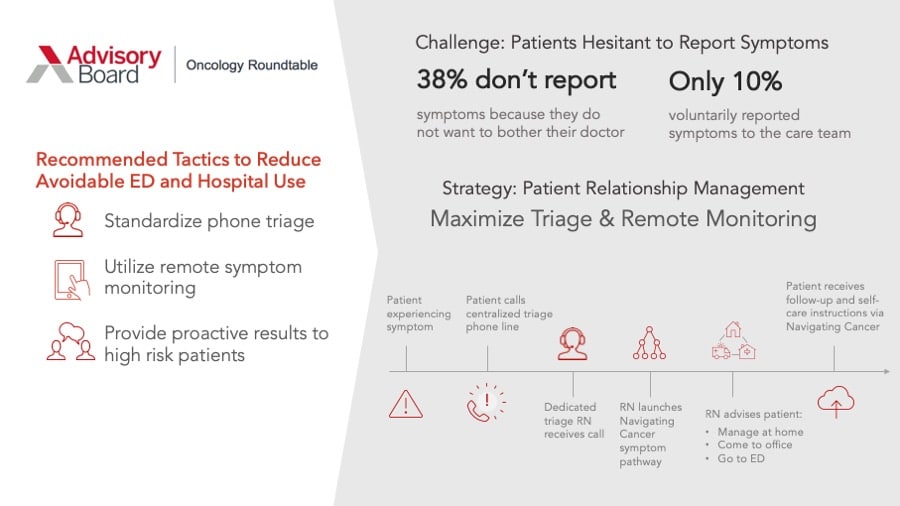We recently returned from the Association of Cancer Executives Annual Meeting where the Advisory Board gave a presentation titled, “Strategies to Keep Your Cancer Patients Out of the ED.” This has been a hot topic in the transition to value-based care – we wrote about it here and the Journal of Oncology Practice recently published a study that concluded proactive management of symptoms does reduce the cost of care. And the Advisory Board’s presentation was another confirmation that symptom management is crucial to keep patients out of the ED.
They highlighted three strategies:
- Strategy 1: Identify drivers of avoidable utilization
- Strategy 2: Encourage patients to report symptoms
- Strategy 3: Dedicate resources to urgent symptom management
These recommended strategies closely parallel our own thinking at Navigating Cancer – we have developed our Patient Relationship Management platform to enable more coordinated and proactive care. Our customer and clinical partner, The Center for Cancer and Blood Disorders (CCBD), was even highlighted during this presentation as a model for phone triage and remote monitoring. During this part of the presentation, the Advisory Board identified barriers for patients to report symptoms including not wanting to bother their care team, not knowing what is considered a serious side effect and not knowing who to contact when a symptom arises. They outlined three tactics to bring down these barriers:

- Standardized phone triage. When all patient needs are added to a shared work board and automatically stratified according to risk, a dedicated triage nurse can quickly assist patients experiencing serious symptoms before they become severe. With embedded symptom management pathways, the triage nurse is guided through a thorough assessment and is empowered to help the patient with physician-approved standing orders. For CCBD, this model resulted in $430,000 in savings in one month.
- Remote symptom monitoring. Several of the barriers cited by the Advisory Board can be addressed with remote monitoring. Instead of expecting patients who are worried about bothering their care team or don’t know who to contact their care team, give them an easy tool to report in on a regular basis. With Navigating Cancer’s Health Tracker, for instance, the patient is prompted via text message to report any symptoms they may be experiencing. That information is added to the care team’s work board, according to severity – that way the patient doesn’t need to feel like they’re bothering the care team and the care team can determine the appropriate follow up.
- Proactive support of high risk patients. With everything that today’s cancer care providers are managing – complex treatments, expanded services, the high cost of drugs and so many other factors – tracking high risk patients can be left to spreadsheets or sticky notes. Using a system that stratifies patient needs, taking into account patients who are high risk or require additional monitoring or support can make a big difference in keeping patients out of the ED.
The Advisory Board recommended several next steps for practices: identify the reasons for the ED use, empower patient to report their symptoms and develop the infrastructure to help patients with urgent symptoms.
If you’re not sure where to start, we can help! Contact us today.
